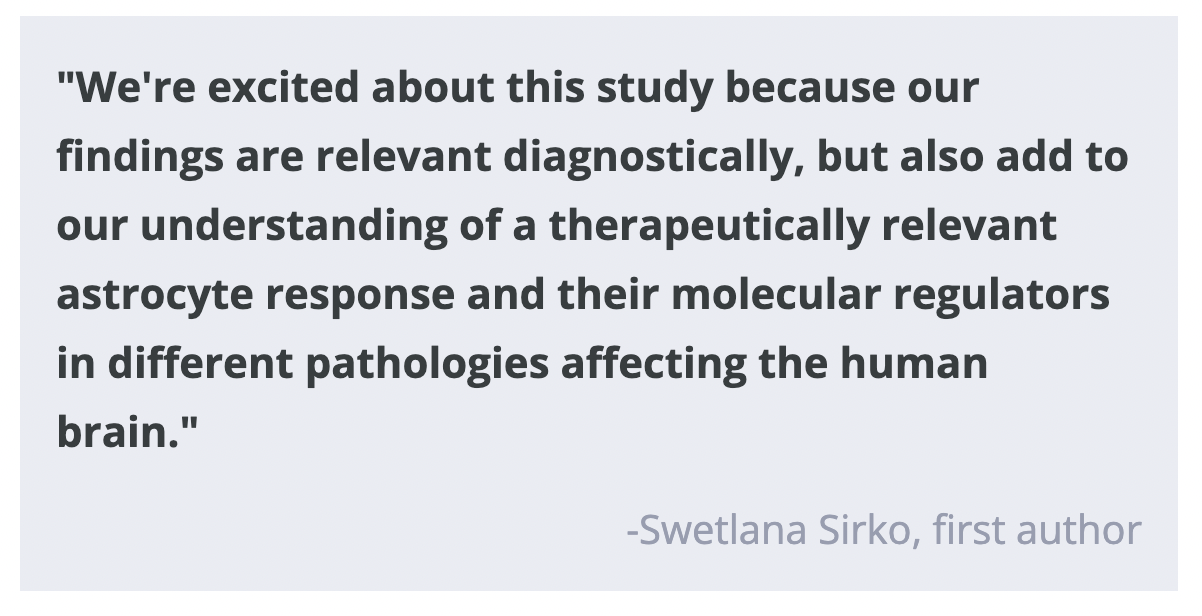How Astrocytes Promote the Growth of New Neurons
Post by Anastasia Sares
The takeaway
Astrocytes are non-neuronal brain cells that react to brain injuries like trauma or stroke. Reactive astrocytes are a source of neural stem cells, which may encourage tissue regeneration at injury sites, including the birth of new neurons (also known as neurogenesis).
What's the science?
The brain is filled with many different cell types, and our understanding of non-neuronal cells lags far behind our understanding of neurons. One such non-neuronal cell type is the astrocyte, which has a multitude of roles in the healthy and injured brain. One of its many jobs is to maintain the blood-brain barrier: a seal around the brain’s blood vessels that keeps out blood cells and other unwanted substances. In mice, it has been shown that when the blood-brain barrier is disrupted by an injury, astrocytes multiply and acquire neural stem cell properties (stem cells can generate other cells of different types and are key to tissue regeneration). This astrocyte activity serves to restrain inflammation and tissue scarring at the site of brain injury.
This week in Nature Medicine, Sirko and colleagues showed that reactive astrocytes in the human brain can act in the same restorative way as in mice, multiplying and exhibiting neural stem cell properties. This happens specifically when there is blood leaking into the brain.
How did they do it?
The authors obtained samples of human brain tissue and cerebrospinal fluid (the fluid that surrounds and bathes the brain and spinal cord) from patients undergoing surgery. The reasons for surgery varied, so they had cases with and without ruptured blood vessels in the brain. Based on previous research, the authors guessed that astrocytes would behave differently as they got closer to an injury, but only for the cases where there was blood vessel leakage.
They sliced the sample tissue into pieces, with each slice being a different distance from the injury core. By bathing the slices in solutions with molecules that would stick to specific proteins and glow under the microscope, they could tag astrocytes to see where they were located and how they reacted to the brain injury. They also kept the brain cells alive in a culture: a container with a mixture of the different chemicals that mimic the right conditions for cells to multiply. They let the cell culture develop for 14 days and then looked for structures called neurospheres, which are blobs generated from single neural stem cells that are self-sustaining while also generating neurons, astrocytes, and other neural cells (click here for a visual). They looked at how the neurospheres developed on their own, and also what would happen if cerebrospinal fluid from a patient with a different type of brain injury was added to the culture.
What did they find?
When the blood-brain barrier was disrupted, astrocytes reacted by multiplying at the site of the injury. These astrocytes also produced a protein called Galectin-3. Related proteins could also be found floating in the cerebrospinal fluid, and there was a significant increase in neurospheres in the cultured tissue from those same patients. In tissue samples from cases with no blood vessel ruptures, there were hardly any neurospheres. However, if the cerebrospinal fluid with Galectin-3 related proteins was added, it induced the formation of neurospheres, regardless of the type of injury.
What does all of this suggest? It seems like astrocytes can produce proteins in response to bleeding that eventually allow them to become neural stem cells, which may then stimulate the formation of new brain tissue.
What's the impact?
This research helps us to understand the regenerative mechanisms at injury sites in the human brain, which could be harnessed for medical applications. Another highly relevant discovery of this research is that, in conditions where the brain’s blood vessels are compromised, there will be specific changes in the protein signature of cerebrospinal fluid, which could allow clinicians to determine the nature and progression of brain injuries.



